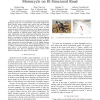Free Online Productivity Tools
i2Speak
i2Symbol
i2OCR
iTex2Img
iWeb2Print
iWeb2Shot
i2Type
iPdf2Split
iPdf2Merge
i2Bopomofo
i2Arabic
i2Style
i2Image
i2PDF
iLatex2Rtf
Sci2ools
IROS
2006
IEEE
2006
IEEE
Vision-based Motion Planning for an Autonomous Motorcycle on Ill-Structured Road
— We report our development of a vision-based motion planning system for an autonomous motorcycle designed for desert terrain, where uniform road surface and lane markings are not present. The motion planning is based on a vision vector space (V2 -Space), which is an unitary vector set that represents local collision-free directions in the image coordinate system. V2 -Space is constructed by extracting the vectors based on the similarity of adjacent pixels, which captures both the color information and the directional information from prior vehicle tire tracks and pedestrian footsteps. We report how V2 Space is constructed to reduce the impact of varying lighting conditions in outdoor environments. We also show how V2 -Space can be used to incorporate vehicle kinematic, dynamic, and timedelay constraints in motion planning to fit the highly dynamic requirements of the motorcycle. The combined algorithm of the V2 -Space construction and the motion planning runs in O(n) time, where n ...
| Added | 12 Jun 2010 |
| Updated | 12 Jun 2010 |
| Type | Conference |
| Year | 2006 |
| Where | IROS |
| Authors | Dezhen Song, Hyun Nam Lee, Jingang Yi, Anthony Levandowski |
Comments (0)

